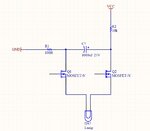Moonwalker
Member level 2
I have a capacitor (slowly charging) and need to discharge it to a floating load. I am currently using a double pole relay to do this but would like to convert the circuit to mosfets. I have attached the circuit but have some doubts that it would work properly.
Any help?
Any help?


